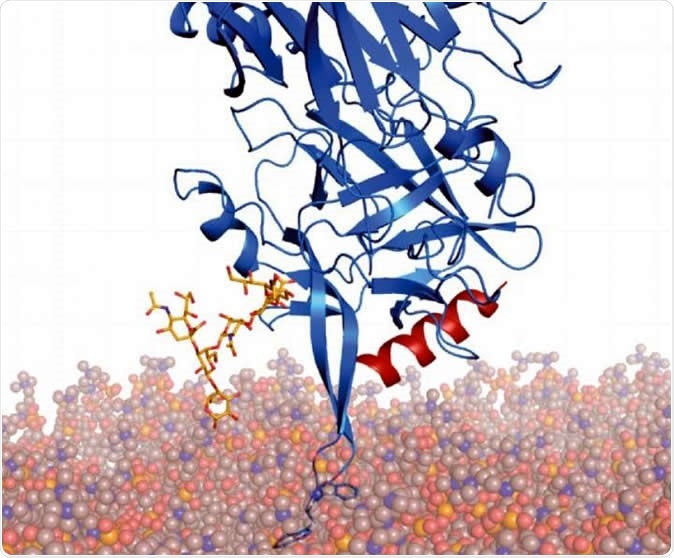A new study reports on an engineered botulinum neurotoxin (botox) that is more effective as well as safer to use in various medical procedures. The study was published in March 2020 in the open-access journal PLOS Biology.
Botulinum neurotoxins (BoNTs) are a group of bacterial toxins, of seven types from A to G. These toxins, produced by the clostridial bacteria, target, and bind to the nerve endings of motor nerves, called the neuromuscular junction, where the nerves stimulate the muscles to contract. This binding is followed by cleavage of one or other proteins essential to further transmission of the nerve impulse, which results in the inhibition of neurotransmitter release and arrest of muscle contraction. This ability to produce local paralysis determines their efficacy and potency over a range of applications.
Two of these toxins are approved for medical and cosmetic uses. Commercial BoNT/A is approved for various conditions characterized by muscle spasm, chronic pain, and wrinkle treatment, while commercial BoNT/B is used in a painful movement disorder called cervical dystonia. Recently, BoNT/B is found to target smooth muscles better than BoNT/A.
BoNTs are typically injected in very tiny amounts into the target tissue to inhibit neuronal activity and to relax the muscle around it. Repeated injections can be given, and the effects usually last months.
However, the better the binding between the toxin and the nerve terminal, the greater is the absorption into the local neurons. This reduces the chances of the toxin migrating into neighboring sites and causing unwanted adverse effects, as well as of immunization to the toxin, which induces resistance to future treatment. The lower effectiveness of BoNT/B in humans compared to BoNT/A is because of reduced binding, which means higher doses are needed to achieve the same clinical effect as the former. High-affinity binding can be restored through specific double point mutations, which increase the binding affinity to the receptors. This generates a mutant BoNT/B with higher efficacy than the natural or wildtype toxin.

Modified BoNT/B (blue) is modeled onto membranes through anchoring with its two receptors (yellow and red), showing that the two tryptophan residues interact with membranes. Image Credit: From Fig 6D, Yin et al, 2020
BoNTs bind to nerve endings via two separate receptors. BoNT/B not only binds to receptors but interacts with the lipid membranes via a specialized extended loop termed the lipid-binding loop or LBL. Such loops are also present in other BoNTs, namely, C, D, and G, as well as the chimeric toxin DC.
This lipid-binding loop (LBL) is thus responsible for independent membrane binding, and certain mutations can result in a marked loss of potency of binding in the affected botox molecule.
The study findings
The researchers examined the interactions between LBL and lipids in a systematic manner in BoNT/B, C, D, G, and DC. They found that while C, DC, and G toxins bind directly to lipids on the cell membrane, independent of receptors, B and D do not. The binding was found to be dependent on the presence of successive aromatic residues at the tip of the LBL and enhances the strength of binding, thus improving the efficacy of the toxin.
Using structural modeling, the researchers deduced that the presence of hydrophobic amino acids promotes such interaction. They introduce their bulky aromatic ring structures into the lipid bilayer while the hydrophilic ends interact with the watery environment outside. Tryptophan, tyrosine, and phenylalanine are all potential candidates for this role. Tryptophan is the strongest and phenylalanine, the weakest among these. Such amino acids are absent in BoNT/B though they are found in several other botulinum toxins.
The investigators, therefore, next turned to add these amino acids to the LBL in BoNT/B so as to enhance its binding to the nerve ending. They engineered the LBL by replacing two non-aromatic residues with the hydrophobic amino acid tryptophan at the tip of the LBL of BoNT/B. This resulted in a “gain-of-function’ mutation, which caused the strong binding to lipid membranes independent of receptors, as well as to neurons in culture.
The researchers then proceeded to generate the full mutant toxin with these tryptophan replacements plus the same double point mutations that had earlier been found to strengthen binding to the receptors. Using a mouse model, they found that it was more effective than the wildtype toxin, in producing local paralysis, while showing limited diffusion, improved safety, and a longer duration of therapeutic action. The treated mice lost less bodyweight, which implies a lesser rate of diffusion of toxin from the site of injection.
The introduction of lipid-binding into the BoNT/B molecule and perhaps into other botulinum toxins thereafter could open up new avenues to achieve engineered botox, with higher efficacy and lower side effects.
Says researcher Min Dong, “Our study shows that the changes introduced into BoNT/B can increase the therapeutic potential of the toxin and reduce adverse effects. Engineering the botulinum toxins in this way may provide a new avenue for improving safety and clinical benefit from these drugs.”
Journal reference:
Yin, L., et al. (2020) Characterization of a membrane binding loop leads to engineering botulinum neurotoxin B with improved therapeutic efficacy. PLOS Biology. doi.org/10.1371/journal.pbio.3000618.